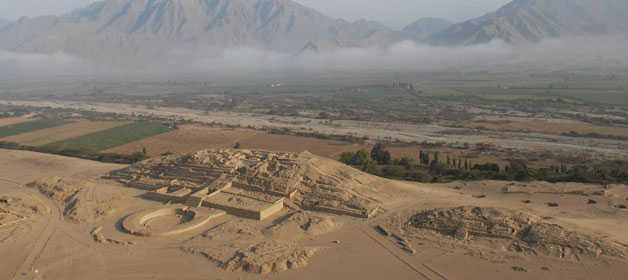Caral is considered by "UNESCO" as Cultural Patrimony of Humanity. Being builders of colossal pyramid-shaped buildings, distinguishes the people of Caral from other peoples of the Andes.

Located on the left bank of the Supe River on a large terrace that is 350 meters above sea level.
The attractions are:
Architectural complex with two components: sunken circular plaza and pyramid with stepped platforms. Located in a dominant position, it controls the activities carried out both in the city and in the middle part of the valley. The most imposing public building, center of political, administrative and religious power.
Building built on a rocky settlement used as a quarry. For the construction of the pyramid a filler was placed in order to level the ground. Its function was mainly ceremonial with some administrative functions.
It is the smallest building of the pyramidal part of the city, in this building administrative and ceremonial activities were practiced.
It is the third structure in terms of dimensions, after the Great Temple and the Ancient Pyramid, to the south of the pyramid of the Gallery is a set of enclosures associated with the pyramid. Its characteristics demonstrate a use for ceremonial and socio-political activities, associated with the high status of its officials.
Named for the orientation of the central staircase in relation to the monolith, it had ceremonial and administrative activities.
Housing complex located on the southern esplanade of the upper half of the city; the dwellings are arranged in subsets with the facades facing the central plaza, it is believed that officials of lower rank were housed here.
Large esplanade towards which the facades of the pyramids and the residences of Caral were oriented. The traces of different posts show the periodic installation of stores for the exchange of products. In the ancient period, a set of interconnected enclosures was formed in the esplanade. Its function changed through time.
Ceremonial construction located in the interior complex of the Temple of the Amphitheater. Of eminently ritual character, its use was restricted.
It is associated with the settlement of Chupacigarro. It represents a head oriented towards the east. It was built through careful planning and knowledge of perspective and proportion in relation to astronomical observations. Its function was to predict the weather and natural phenomena in relation to their activities.
Monday to Sunday from 9:00h to 17:00h.
General admission: S/.11.20 nuevos soles
Reduced rate: students and teachers: 3.60 nuevos soles
schoolchildren and retirees: S/. 1.00 nuevos soles
Guided tour for groups: S/. 20.00 nuevos soles.

Happy passengers